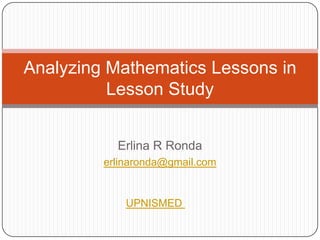
Planning and analyzing mathematics lesson
- 1. Analyzing Mathematics Lessons in Lesson Study Erlina R Ronda erlinaronda@gmail.com UPNISMED
- 2. Planning and Implementing Effective Lessons Lesson Study at Sta Lucia High School (2010) E.Ronda UPNISMED
- 3. 1. Set clear objectives that enhance students’ learning Not good: Students will find the area of an L-shape polygon Better: Students will find the area of an L-shape polygon using their knowledge for calculating the area of rectangles and squares Best: Students will understand that they can find the area of an L-shape polygon by changing it into familiar ones E.Ronda UPNISMED
- 4. 2. Link the lesson content to the curriculum, the unit, prior lesson, and future lessons What have my students studied previously that is related to this topic? What will my students study in the future that will build upon this topic? E.Ronda UPNISMED
- 5. Example of links in the lesson Finding the area of an L-shape figure Connection to prior knowledge about area of squares and rectangles The area of a figure is equal to the sum of the area of its parts Cutting and rearranging pieces of figure does not change the area These ideas are the foundation for approaching the area of parallelograms, triangles and area of compound figures that students will study later. E.Ronda UPNISMED
- 6. 3. Provide meaningful tasks or problems It must be accessible to students with their current understanding It must have multiple entry points and multiple solution paths It should capture students attention It must be meaningful to them (not necessarily real-world problems) Students can generate their own questions from the task. E.Ronda UPNISMED
- 7. 4. Anticipate and plan for students’ difficulties The purpose is not always to avoid the challenges. Explicit discussion of particular challenges may be beneficial to students Having multiple contingency plans will allow teachers to deal with those challenges more effectively. E.Ronda UPNISMED
- 8. 5. Provide necessary materials and technology for all students to access the task Plan for what materials to provide and when to provide it. How will it generate and facilitate students discussion in small groups, in the whole class? E.Ronda UPNISMED
- 9. Key questions to support learning Questions that should help students reflect, evaluate, and summarize their learning Questions that ask students to recall and connect to prior experiences that may connect to the current task to initiate thinking Questions that ask students to compare and contrast various ideas that would deepen thinking E.Ronda UPNISMED
- 10. 6. Group students to provide opportunities for them to express ideas Learning can be hindered by inappropriate grouping of students Balance the students’ need to think and solve independently and their need to exchange ideas E.Ronda UPNISMED
- 11. 7. Identify additional tasks/problems to help students solidify and extend their understanding E.Ronda UPNISMED
- 12. 8. Assess students’ understanding How will the students problem solving be different if they have not been taught this lesson? E.Ronda UPNISMED
- 13. Analyzing and revising the lesson Lesson Study at Ligao National High School (2011) E.Ronda UPNISMED
- 14. Attainment of objectives Did the students see the connection between the topic that students previously learned and the one they learned during the class? What seems to prompt students to make this connection? What changes might promote students to make connections more effectively? Did the lesson activities encourage students to learn continuously after the lesson Did the students understand how and why the topic is important? Did the students accomplish the learning obejectives? E.Ronda UPNISMED
- 15. Learning tasks and materials Was the degree of challenge appropriate for the students at the time? If not, what seems to be missing? Was there any unanticipated response? Did the lesson provide opportunities for students to express math ideas and thinking process in individual writing and the class/group discussion Did the lesson incorporate use of visualization and communication tools that include board writing? Did the lesson provide students to extend/secure their knowledge/understanding/skills (extension problems and/or exercises during the lesson outside the class)? E.Ronda UPNISMED
- 16. Teacher questioning and support for students learning Did the teacher’s questions and guidance enhance students learning? Which questions seem to enhance students’ learning? Did teacher provide appropriate support for students to overcome misconceptions and misunderstanding? What was the misconception and was support promoted overcoming it? Was grouping (individual, pairs, small groups, whole class) used appropriately to maximize students learning? E.Ronda UPNISMED
- 17. Effective integration of assessment Did the teacher use formative assessments to make decisions to modify/adjust the plan to maximize students learning? Were the methods for evaluation appropriate? E.Ronda UPNISMED
- 18. Reference: Guide for Planning and Analyzing Mathematics Lessons in Lesson Study published by APEC More pages on Lesson Study 1. What is Lesson Study? 2. Lesson Study Readings 3. How to facilitate a lesson study group 4. Lesson study on teaching subtraction of integers E.Ronda UPNISMED
Hinweis der Redaktion
- Students own questions and reasoning play the central role in the lesson